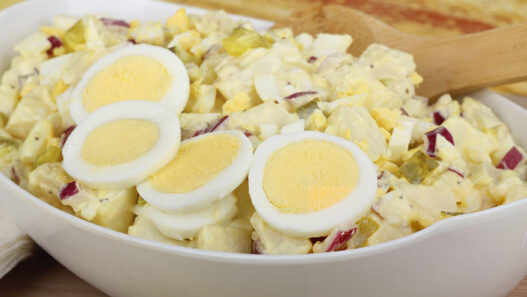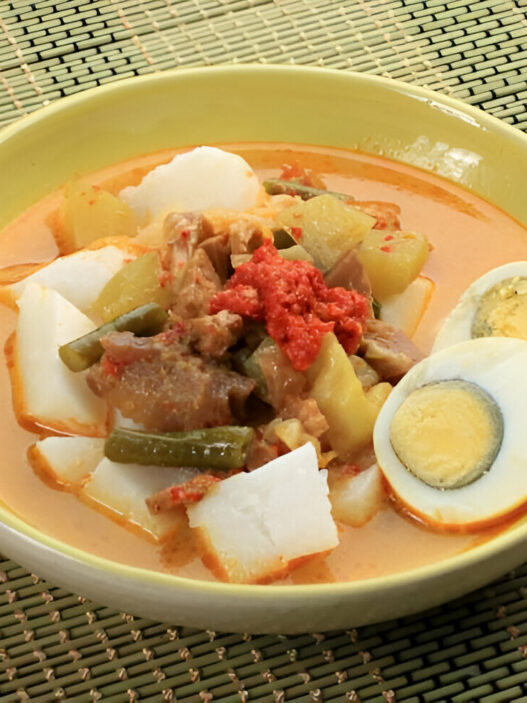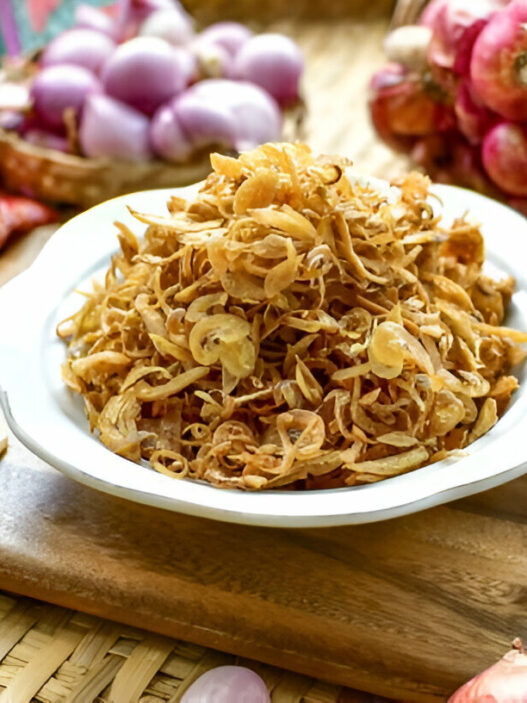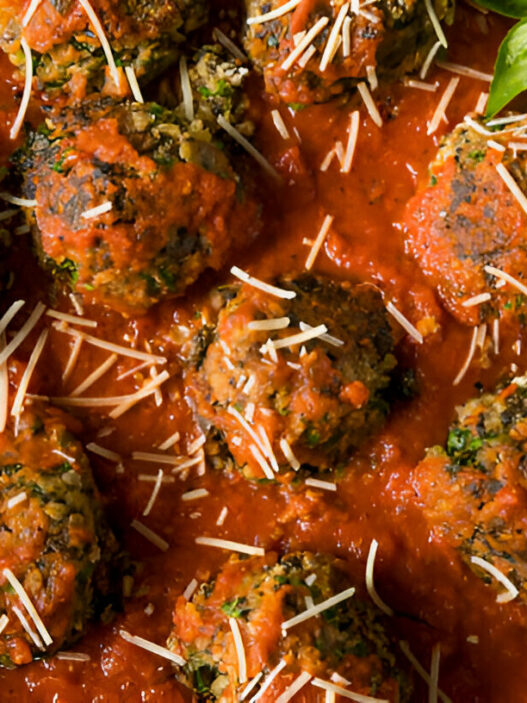Crisp on the outside, soft on the inside, and dripping with warm, creamy sweetness—this roti is the kind of comfort food that feels like a hug. It’s pan-fried to golden perfection and filled with sweet banana and egg, then finished with a generous pour of condensed milk that melts into every corner.
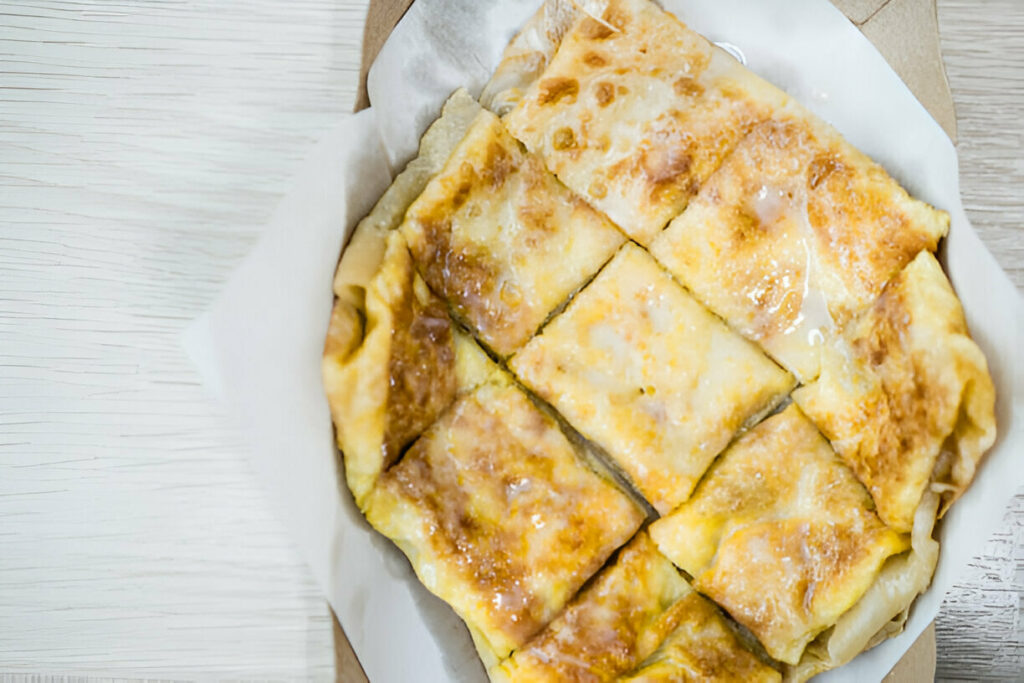
Ingredients Breakdown
The dough begins with a basic base—flour and salt—yet what makes it special are the layers of richness added through butter and condensed milk. This combination gives the dough an ultra-supple texture that stretches effortlessly and crisps beautifully on the griddle.
Room temperature water is crucial in hydrating the flour evenly. It keeps the dough pliable and ensures that the finished roti remains tender and flaky, not tough or rubbery. The balance between moisture and fat in the dough is what creates that dreamy texture.
Butter isn’t just for cooking—it’s built into the dough and added during pan-frying. Melted into the dough, it makes it soft and rich. In the pan, it helps crisp the roti’s surface while imparting a buttery aroma that’s utterly irresistible.
Though optional, the egg in the filling transforms the banana into something custardy and satisfying. It adds body, sets up slightly during cooking, and binds everything into a creamy center.
Choosing ripe bananas is key—they should be just soft enough to mash slightly, but not overly browned. This ripeness enhances the flavor without making the filling too watery.
Condensed milk is the final flourish. Sweet, thick, and slightly caramelized, it melts over the hot roti and seeps into every layer, creating a luscious finish that contrasts beautifully with the crispy exterior.
Step-by-Step Preparation Guide
To begin the dough, combine the flour and salt in a large bowl. Separately whisk together the water, egg, butter, and condensed milk until smooth. Pour this mixture over the flour and gently mix with your hands until a rough dough forms with no dry spots.
Let the dough rest for 20 minutes. This allows the gluten to relax and absorb moisture fully, making kneading much easier. After resting, knead the dough for 5 minutes until it becomes soft, smooth, and slightly tacky to the touch. Add a little extra flour if necessary, but keep the dough supple.
After another short rest, divide the dough into 10 equal portions. Roll each into a rough ball. Coat each one in oil and place them on a tray, covered tightly with plastic wrap. Refrigerate the dough overnight to give it time to relax and develop elasticity, which makes stretching easier later.
When you’re ready to cook, take out the dough an hour or two in advance to bring it back to room temperature. Meanwhile, beat an egg and mix it with thinly sliced banana to create your filling. This ensures even distribution and a soft-set texture when cooked.
To stretch the dough, oil a clean surface and press the dough flat with your palms, then use your fingers to gently pull it outward into a thin, translucent circle. Aim for a diameter of about 10–12 inches. The dough should be stretchy but not tearing.
Heat a lightly oiled pan over medium heat until shimmering. Carefully transfer the stretched dough to the pan, letting it cook briefly before spooning the banana-egg filling into the center. Fold the edges inward to form a neat square parcel.
Flip the roti and add a bit of butter to the pan. Let it sizzle and crisp, flipping every 30 seconds or so to cook evenly. The surface should turn golden brown with small, crunchy bubbles forming on the crust.
Once done, transfer the roti to a board and cut into squares—six or nine pieces depending on how you like it. While still hot, drizzle generously with condensed milk so it melts into the folds. Repeat the process for as many rotis as you wish to serve.
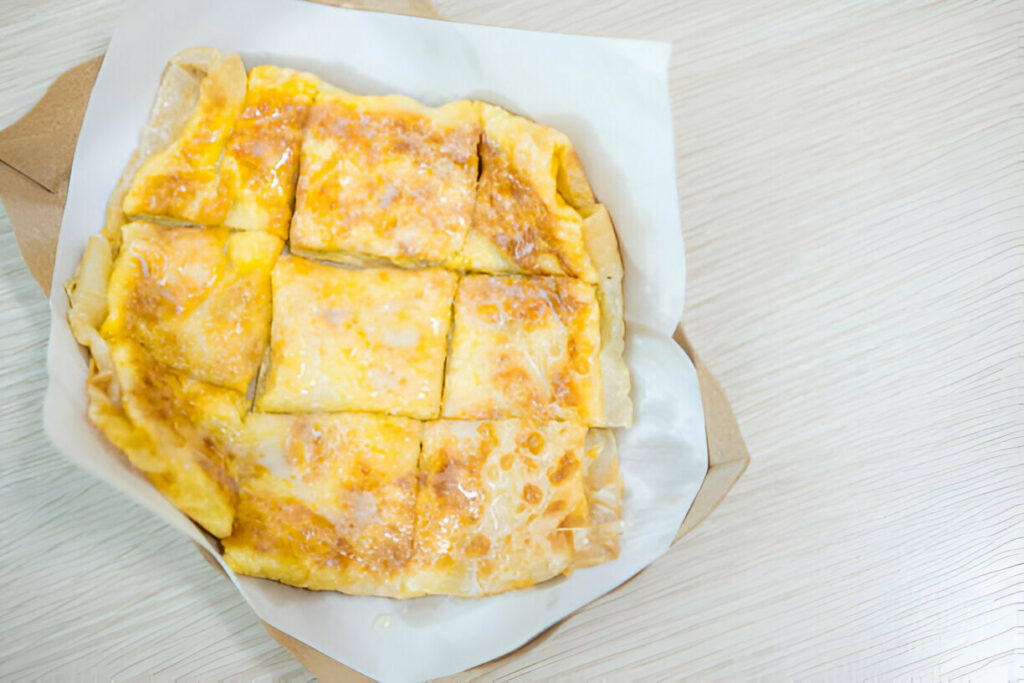
Recipe Tips
How to prevent the dough from tearing while stretching:
Ensure the dough is well-rested, oiled, and at room temperature. Cold dough resists stretching and tears easily.
Tips for even browning without burning:
Keep the heat at medium and watch closely, adjusting as needed. Too hot and the roti burns before cooking through.
Why resting the dough overnight creates a better texture:
This gives gluten time to relax, making the dough softer and easier to stretch without resistance.
How to prep ahead and store unused dough balls:
Oiled and wrapped tightly, dough balls can be kept refrigerated for up to 3 days.
The best way to keep cooked roti warm and crisp for serving:
Place them on a wire rack in a low oven (about 200°F) uncovered to prevent sogginess.
What to Serve With This Recipe
This sweet roti pairs beautifully with creamy Thai iced tea or classic milk tea. The slight bitterness of the tea balances the richness of the roti for the perfect street-food-style treat.
For an extra indulgent dessert, serve it with a scoop of coconut or vanilla ice cream. The contrast of hot, crispy roti and cold, melty ice cream is a guaranteed crowd-pleaser.
To balance the sweetness, you can also pair the roti with savory dishes—like spiced chicken skewers or herb-filled omelets—for a fun twist on breakfast-for-dinner.
Finish it with a dusting of cinnamon, cocoa powder, or even crushed peanuts to add texture and deepen the flavor.
Frequently Asked Questions
Can I skip the egg in the filling?
Yes, but the texture won’t be as rich. The egg binds the banana and adds a custardy finish.
What if I don’t have a 15-inch work surface?
You can still make it—just stretch the dough as wide as you can comfortably manage. A smaller roti will still taste amazing.
Can I use store-bought roti or paratha dough instead?
You can, though it won’t have quite the same soft chew or flavor. Homemade dough gives you better control over the texture.
How long can I store the dough in the fridge?
Up to 3 days, as long as the dough balls are coated in oil and well-wrapped to prevent drying out.
Can I cook the roti in advance and reheat it later?
Yes. Reheat on a dry skillet or in a low oven to regain crispness. Avoid microwaving, which makes it soggy.
Creative Variations
Try swapping banana for sliced strawberries, apples, or mango for a fruity twist. Mango and coconut milk is a particularly lush combo.
Add a layer of Nutella before folding for a chocolatey treat that oozes with every bite.
For a savory-sweet twist, add shredded cheese to the filling and reduce the condensed milk drizzle.
Drizzle with salted caramel or honey instead of condensed milk for a flavor change, or dust with toasted sesame seeds for crunch.
This roti with egg and condensed milk is more than just a street snack—it’s a crave-worthy creation that blends crispy textures with gooey, sweet richness. Whether served for dessert, brunch, or a midnight bite, its playful layers and comforting warmth make it a recipe worth mastering and sharing again and again.
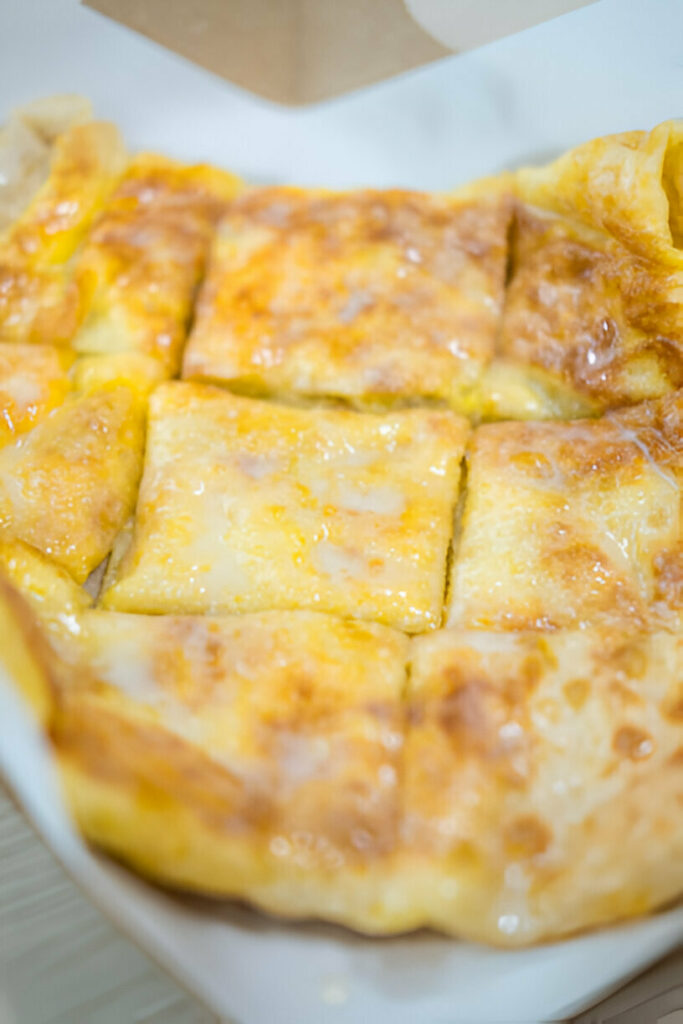
Ingredients
Roti Dough (makes approximately 10 roti)
250 grams water, at room temperature
1 egg, beaten (approximately 55 grams)
50 grams unsalted butter, melted
18 grams sweetened condensed milk (about 1 tablespoon)
450 grams all-purpose flour
2 grams salt
Neutral-flavored cooking oil, as needed
Roti Filling/Topping (per roti)
1 banana
1 egg (optional but highly recommended)
2–4 tablespoons sweetened condensed milk
1/2 tablespoon unsalted butter
Neutral-flavored cooking oil, as needed
Instructions
Roti Dough
This dough yields 10 portions. If you’re planning to cook fewer, simply halve the ingredients for a smaller batch. For a full batch, make sure to scale your filling accordingly—10 bananas, 10 eggs, and so on.
Begin by combining the dry ingredients. In a mixing bowl, whisk together the all-purpose flour and salt. In a separate bowl, mix the beaten egg, room temperature water, melted butter, and condensed milk until fully combined.
Pour the wet mixture into the dry ingredients. Using your hands, bring the dough together until all the flour is absorbed. The dough will be rough and shaggy at this stage, and that’s perfectly fine. No kneading is needed yet.
Cover the bowl with plastic wrap or foil and let it rest at room temperature for 20 minutes. This resting period allows the flour to hydrate and makes kneading easier.
After resting, knead the dough directly in the bowl for about 5 minutes. The goal is a smooth, elastic texture that’s soft to the touch. The dough should be slightly tacky but not wet. If it sticks excessively to your fingers, sprinkle in a bit more flour—just a teaspoon at a time—until it reaches the right consistency.
Cover the bowl again and let it rest for another 15 minutes at room temperature. Once rested, turn the dough out onto a clean, unfloured surface. Divide it evenly into 10 portions, each weighing approximately 80–85 grams. If you’re using a smaller pan (less than 12 inches), consider scaling each portion down to 60 grams for ease of handling.
Shape each portion into a rough ball. Perfection isn’t necessary here. Pour a few tablespoons of oil into a small bowl and roll each dough ball in the oil to fully coat. Transfer them to a tray or plate, ensuring they’re slightly spaced apart. Cover tightly with plastic wrap and refrigerate for at least 4 hours, preferably overnight.
Making the Roti (per piece)
Remove the dough balls from the refrigerator 1 to 2 hours before cooking to allow them to come back to room temperature. Keep them covered to prevent drying out.
Lightly beat one egg in a bowl. Slice the banana into thin rounds and gently stir it into the egg mixture to make your filling.
Lightly oil a skillet and start heating it over low to medium-low heat. The key is to have the pan hot and ready once the dough is fully stretched.
Lightly oil a smooth, flat workspace about 15 x 15 inches in size. Place one dough ball in the center. If it’s become misshapen, reshape it gently into a ball.
Flatten it using the palm of your hand until it spreads to about 4–5 inches in diameter. Continue pressing outward in a circular motion. Then, using your fingertips, stretch the dough gently but firmly from the center outward. Keep working until it reaches around 10–12 inches in diameter, forming a very thin, almost translucent sheet.
Increase the heat under the pan to medium or medium-high. The oil should shimmer but not smoke. Carefully lift the stretched dough from the counter, spreading your fingers beneath it to keep it from folding.
Place the dough gently in the hot pan. It should begin to puff and sizzle almost immediately. Let it cook for 15–30 seconds, or until the surface looks just cooked through.
Spoon the banana-egg mixture into the center of the dough. Once the roti has set enough to handle, begin folding the edges inward. Fold one side toward the center, followed by the opposite side, then the top and bottom—forming a square package around the filling.
Flip the folded roti over and add the 1/2 tablespoon of butter to the pan. Adjust the heat if necessary to ensure it browns evenly without burning. Continue flipping the roti every 30 seconds or so, letting it cook in the butter for 2–3 minutes, until the surface turns golden and crisp.
Transfer the cooked roti to a cutting board and slice into squares—six or nine pieces, depending on your preference.
Place the warm roti on a serving plate and drizzle generously with sweetened condensed milk. Repeat the process for additional roti, using the remaining dough balls and filling.
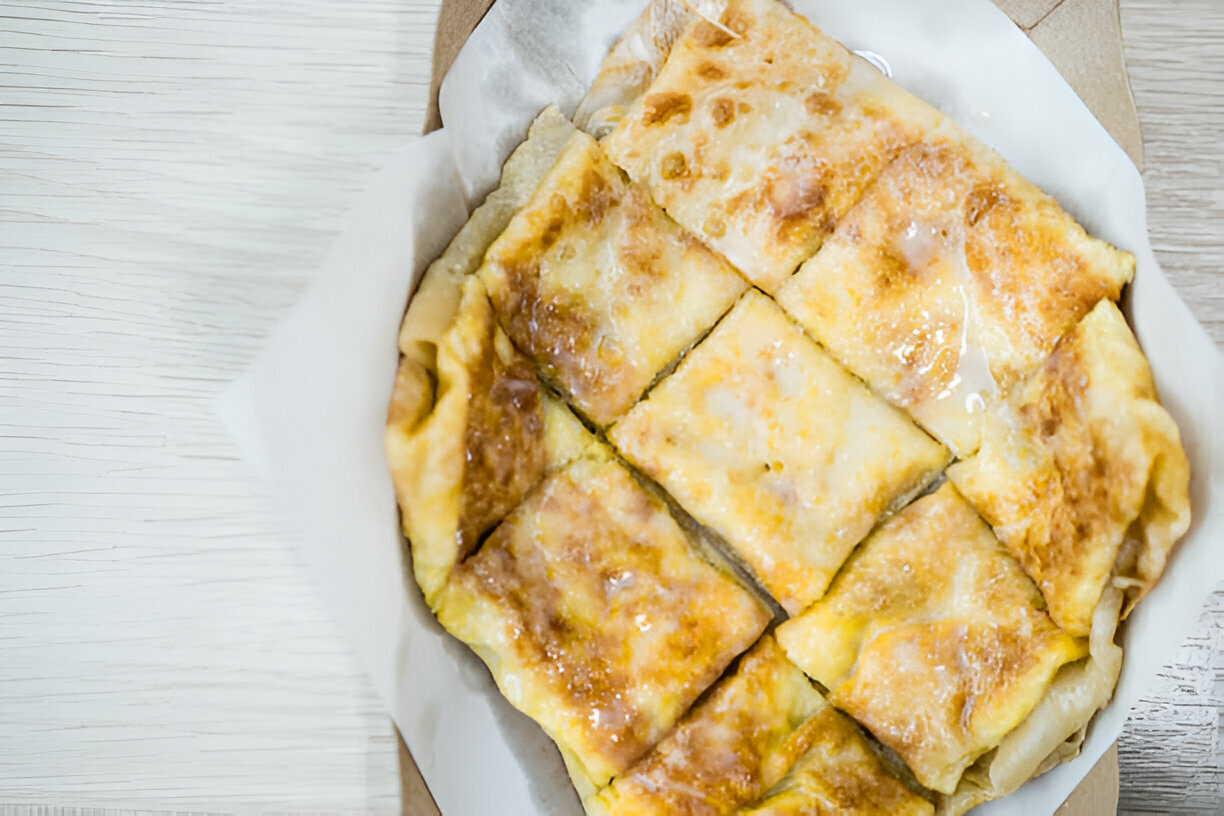
Roti with Egg and Sweetened Condensed Milk Recipe
Ingredients
Roti Dough (makes approximately 10 roti)
- 250 grams water at room temperature
- 1 egg beaten (approximately 55 grams)
- 50 grams unsalted butter melted
- 18 grams sweetened condensed milk about 1 tablespoon
- 450 grams all-purpose flour
- 2 grams salt
- Neutral-flavored cooking oil as needed
Roti Filling/Topping (per roti)
- 1 banana
- 1 egg optional but highly recommended
- 2 –4 tablespoons sweetened condensed milk
- 1/2 tablespoon unsalted butter
- Neutral-flavored cooking oil as needed
Instructions
Roti Dough
- This dough yields 10 portions. If you’re planning to cook fewer, simply halve the ingredients for a smaller batch. For a full batch, make sure to scale your filling accordingly—10 bananas, 10 eggs, and so on.
- Begin by combining the dry ingredients. In a mixing bowl, whisk together the all-purpose flour and salt. In a separate bowl, mix the beaten egg, room temperature water, melted butter, and condensed milk until fully combined.
- Pour the wet mixture into the dry ingredients. Using your hands, bring the dough together until all the flour is absorbed. The dough will be rough and shaggy at this stage, and that’s perfectly fine. No kneading is needed yet.
- Cover the bowl with plastic wrap or foil and let it rest at room temperature for 20 minutes. This resting period allows the flour to hydrate and makes kneading easier.
- After resting, knead the dough directly in the bowl for about 5 minutes. The goal is a smooth, elastic texture that’s soft to the touch. The dough should be slightly tacky but not wet. If it sticks excessively to your fingers, sprinkle in a bit more flour—just a teaspoon at a time—until it reaches the right consistency.
- Cover the bowl again and let it rest for another 15 minutes at room temperature. Once rested, turn the dough out onto a clean, unfloured surface. Divide it evenly into 10 portions, each weighing approximately 80–85 grams. If you’re using a smaller pan (less than 12 inches), consider scaling each portion down to 60 grams for ease of handling.
- Shape each portion into a rough ball. Perfection isn’t necessary here. Pour a few tablespoons of oil into a small bowl and roll each dough ball in the oil to fully coat. Transfer them to a tray or plate, ensuring they’re slightly spaced apart. Cover tightly with plastic wrap and refrigerate for at least 4 hours, preferably overnight.
Making the Roti (per piece)
- Remove the dough balls from the refrigerator 1 to 2 hours before cooking to allow them to come back to room temperature. Keep them covered to prevent drying out.
- Lightly beat one egg in a bowl. Slice the banana into thin rounds and gently stir it into the egg mixture to make your filling.
- Lightly oil a skillet and start heating it over low to medium-low heat. The key is to have the pan hot and ready once the dough is fully stretched.
- Lightly oil a smooth, flat workspace about 15 x 15 inches in size. Place one dough ball in the center. If it’s become misshapen, reshape it gently into a ball.
- Flatten it using the palm of your hand until it spreads to about 4–5 inches in diameter. Continue pressing outward in a circular motion. Then, using your fingertips, stretch the dough gently but firmly from the center outward. Keep working until it reaches around 10–12 inches in diameter, forming a very thin, almost translucent sheet.
- Increase the heat under the pan to medium or medium-high. The oil should shimmer but not smoke. Carefully lift the stretched dough from the counter, spreading your fingers beneath it to keep it from folding.
- Place the dough gently in the hot pan. It should begin to puff and sizzle almost immediately. Let it cook for 15–30 seconds, or until the surface looks just cooked through.
- Spoon the banana-egg mixture into the center of the dough. Once the roti has set enough to handle, begin folding the edges inward. Fold one side toward the center, followed by the opposite side, then the top and bottom—forming a square package around the filling.
- Flip the folded roti over and add the 1/2 tablespoon of butter to the pan. Adjust the heat if necessary to ensure it browns evenly without burning. Continue flipping the roti every 30 seconds or so, letting it cook in the butter for 2–3 minutes, until the surface turns golden and crisp.
- Transfer the cooked roti to a cutting board and slice into squares—six or nine pieces, depending on your preference.
- Place the warm roti on a serving plate and drizzle generously with sweetened condensed milk. Repeat the process for additional roti, using the remaining dough balls and filling.

